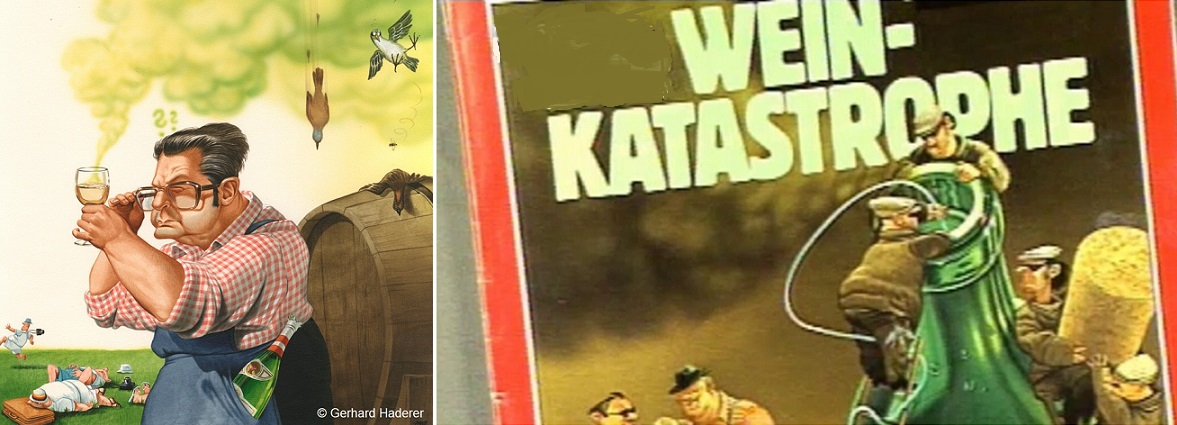In 2008, Italy saw the so-called "Brunellopoli scandal", also known in the Anglo-American press as "Brunellogate" (derived from "Watergate"). See under wine scandal.
Wine scandal
Such incidents of prohibited or even harmful wine manipulation date back to ancient times. Attempts are made to "improve" quality through unauthorised additives or to feign a false identity through manipulations such as fraudulent labelling or blending with inferior wines, circumventing wine regulations. The most spectacular and extensive wine counterfeits of modern times are described below:
Artificial wine scandal Italy 1968
In the 1960s, Italian wines became popular, particularly in Germany, due to Italy becoming a popular holiday destination at the time, and millions of hectolitres were imported. These included the cheapest products of alleged brands such as Chianti (in the kitschy, bast-wrapped demijohns), Lambrusco and Valpolicella, which had never seen the growing regions concerned. Many were enriched with sugar and water, embellished with bovine blood and the plant mucilage agar agar (made from algae) and the fiery lustre was created by adding plaster. Over 200 wine adulterators were reported, some of whom had also used river water and the broth of spoilt figs or bananas to sweeten the wine. The wine law introduced in 1963 with the DOC system had clearly not yet taken effect.
Glycol scandal Austria 1985
In a 2010 interview with Josef Pleil, the long-term president of the Austrian Winegrowers' Association, he explained the background to the 1985 glycol scandal (heavily abridged): The roots for the wine scandal probably lie in the early 1970s. In order to prevent the exodus of many small farmers, every winegrower from the border region was authorised to plant an additional 0.5 hectares per farm. This was intended to prevent the many small farmers from entering the Viennese labour market. After just five years, this resulted in an expansion of around 15,000 hectares of vineyards and thus overproduction. At the beginning of the 1980s, however, wine consumption declined throughout Europe.
In Germany at that time, there was good demand for sweet wines. Some "resourceful specialists" tried to meet this demand by adding diethylene glycol to simple, cheap table wines to simulate high-quality Prädikat wines and offering them at very low prices. This worked quite well at first.
First suspicion
In December 1984, an unknown man with a German accent turned up at the Federal Agricultural and Chemical Institute in Vienna, placed a bottle containing a syrupy liquid on the table and remarked: "This is what the Austrian wine counterfeiting scene uses". It was the diethylene glycol used in antifreeze. After mass production in the 1970s and the fall in the price of Austrian quality wines, the state winery inspectors had long had a vague suspicion. So much Prädikat wine could not be produced naturally. But applications to search the premises of suspected wine merchants were regularly rejected by the court as disproportionate.

Use of diethylene glycol
Of course, there were already analytical quality samples for wines back then, but the detection limit at the time was 200 mg diethylene glycol per litre of wine. However, this was well known in the wine counterfeiting scene. In order to reduce the glycol content to below the laboratory detection limit, it was mixed one to ten with unadulterated wine. As a result of the information described above, laboratory methods were refined in Austria, and now glycol wine could be recognised as adulterated from as little as 5 mg/l using the gas chromatography method. When word of this got around in the counterfeiting scene, sewage treatment plants collapsed because the glycolic wine was poured into the sewer in extreme quantities that are still unknown today, just to avoid being convicted or caught. Hundreds of thousands of hectolitres of wine had to be distilled into industrial alcohol.
Table wine became Prädikat wine
The majority was produced by winegrowers from Lower Austria and Burgenland, some of whom were also advised by a chemist. Diethylene glycol was added to give the wine more "body and sweetness ", which was particularly appreciated by consumers in Germany at the time. Glycol was not only used to turn ordinary...
Voices of our members

The wein.plus encyclopaedia is a comprehensive, well-researched reference work. Available anytime and anywhere, it has become an indispensable part of teaching, used by students and myself alike. Highly recommended!
Dominik Trick
Technischer Lehrer, staatl. geprüfter Sommelier, Hotelfachschule Heidelberg